Related Research Articles
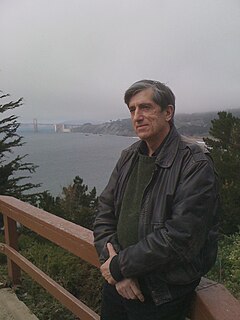
Kevin Wayne Jeter, is an American science fiction and horror author known for his literary writing style, dark themes, and paranoid, unsympathetic characters. He has written novels set in the Star Trek and Star Wars universes, and has written three sequels to Blade Runner. Jeter also gained recognition for coining the term “steampunks.”
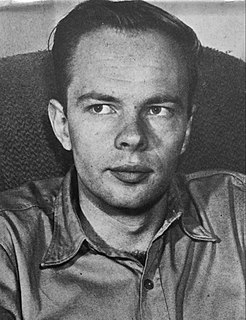
Philip Kindred Dick was an American science fiction writer. He wrote 44 novels and about 121 short stories, most of which appeared in science fiction magazines during his lifetime. His fiction explored varied philosophical and social questions such as the nature of reality, perception, human nature, and identity, and commonly featured characters struggling against elements such as alternate realities, illusory environments, monopolistic corporations, drug abuse, authoritarian governments, and altered states of consciousness.

A Scanner Darkly is a science fiction novel by American writer Philip K. Dick, published in 1977. The semi-autobiographical story is set in a dystopian Orange County, California, in the then-future of June 1994, and includes an extensive portrayal of drug culture and drug use. The novel is one of Dick's best-known works and served as the basis for a 2006 film of the same name, directed by Richard Linklater.

Do Androids Dream of Electric Sheep? is a dystopian science fiction novel by American writer Philip K. Dick, first published in 1968. The novel is set in a post-apocalyptic San Francisco, where Earth's life has been greatly damaged by a nuclear global war, leaving most animal species endangered or extinct. The main plot follows Rick Deckard, a bounty hunter who is tasked with "retiring" six escaped Nexus-6 model androids, while a secondary plot follows John Isidore, a man of sub-par IQ who aids the fugitive androids.
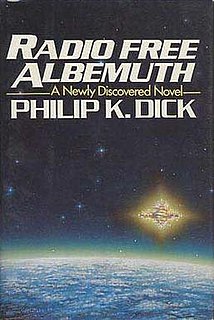
Radio Free Albemuth is a dystopian novel by Philip K. Dick, written in 1976 and published posthumously in 1985. Originally titled VALISystem A, it was his first attempt to deal in fiction with his experiences of early 1974. When his publishers at Bantam requested extensive rewrites he canned the project and reworked it into the VALIS trilogy. Arbor House acquired the rights to Radio Free Albemuth in 1985. They then published an edition under the current title, prepared from the corrected typescript given by Dick to his friend Tim Powers.

The Transmigration of Timothy Archer is a 1982 novel by American writer Philip K. Dick. As his final work, the book was published shortly after his death in March 1982, although it was written the previous year.
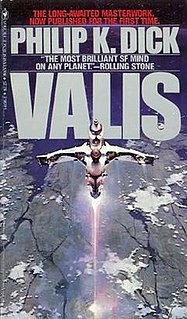
Valis is a 1981 science fiction novel by American writer Philip K. Dick, it is one book of a three part series. The title is an acronym for Vast Active Living Intelligence System, Dick's gnostic vision of God. Set in California during the 1970s, the book features heavy auto-biographical elements and draws inspiration from Dick's own investigations into his unexplained religious experiences over the previous decade.
The VALIS trilogy is a set of science fiction/philosophical novels by author Philip K. Dick which include VALIS (1978), The Divine Invasion (1980), and The Transmigration of Timothy Archer (1982). Dick's first novel about the VALIS concept originally titled "VALISystem A", was published as Radio Free Albemuth after Dick's death in 1985.

The Exegesis of Philip K. Dick is a 2011 non-fiction book containing the published selections of a journal kept by the science fiction writer Philip K. Dick, in which he documented and explored his religious and visionary experiences. Dick's wealth of knowledge on the subjects of philosophy, religion, and science inform the work throughout.
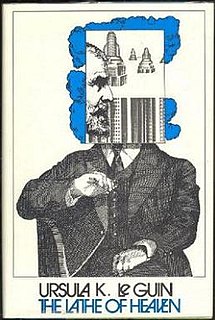
The Lathe of Heaven is a 1971 science fiction novel by American writer Ursula K. Le Guin. The plot concerns a character whose dreams alter past and present reality. The story was serialized in the American science fiction magazine Amazing Stories. The novel received nominations for the 1972 Hugo and the 1971 Nebula Award, and won the Locus Award for Best Novel in 1972. Two television film adaptations were released: the PBS production, The Lathe of Heaven (1980), and Lathe of Heaven (2002), a remake produced by the A&E Network.

The Divine Invasion is 1981 science fantasy novel by American writer Philip K. Dick. It is the second book in the gnostic VALIS trilogy, and takes place in the indeterminate future, perhaps a century or more after VALIS. The novel, originally titled Valis Regained, was nominated to the BSFA Award.
"The Eye of the Sibyl" is a science fiction short story by American writer Philip K. Dick. It was written sometime around 1975, but not published until 1987 when it was included in volume 5 of The Collected Stories of Philip K. Dick, and has been reprinted since in other editions of this book such as the U.S. edition The Eye of the Sibyl and Other Stories.
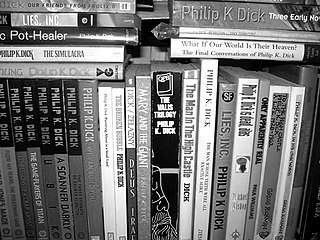
The bibliography of Philip K. Dick includes 44 novels, 121 short stories, and 14 short story collections published by American science fiction author Philip K. Dick during his lifetime.

Voices From The Street is an early realist novel by American science fiction author Philip K. Dick, written in the early 1950s. Unpublished at the time, it was released on January 23, 2007, by Tor Books for the first time.
A Time for George Stavros was an early, unpublished, non-science fiction novel by author Philip K. Dick. It was written sometime around 1955, a time when Dick was getting his science fiction published but still dreamed of being a mainstream writer.
Pilgrim on the Hill was a lost, early, non-science fiction novel by Philip K. Dick. It was written somewhere around 1956 according to one account, or between 1948 and 1950 according to another account. According to Lawrence Sutin's book, Divine Invasions: A Life of Philip K. Dick, the plot survives only as an index card synopsis from the publisher dated 11/08/1956 as follows:
Nicholas and the Higs is one of several early, unpublished novels by American science fiction author Philip K. Dick. It was written somewhere around 1957 during the waning days of his second marriage, was re-written at the behest of his publisher in 1958, and was then ultimately rejected for publication. The original manuscripts have been lost, and no copies are known to be extant.

Radio Free Albemuth is a 2010 American film adaptation of the dystopian novel Radio Free Albemuth by author Philip K. Dick, which was written in 1976 and published posthumously in 1985. The film is written, directed, and produced by John Alan Simon and stars Jonathan Scarfe and Shea Whigham.

Lawrence Sutin is the author of two memoirs, two biographies, a novel and a work of history.
References
- 1 2 Lee, Gwen; Sauter, Doris Elaine (2000). What If Our World Is Their Heaven? The Final Conversations of Philip K. Dick. pp. 49–140. ISBN 1-58567-378-1.
- ↑ "Widow self-publishes 'recreation' of Philip K Dick's final novel". TheGuardian.com . 16 February 2009.
- ↑ Baum, Henry (February 12, 2009). "Interview with Tessa Dick, Widow of Philip K. Dick". Self-Publishing Review.